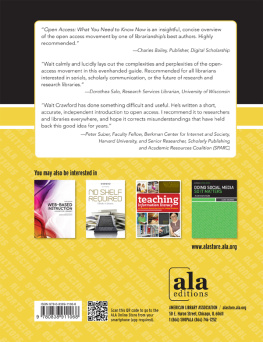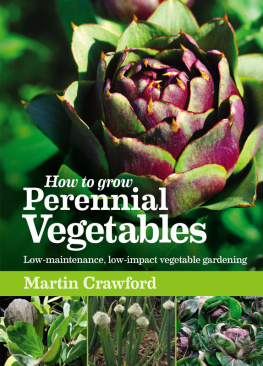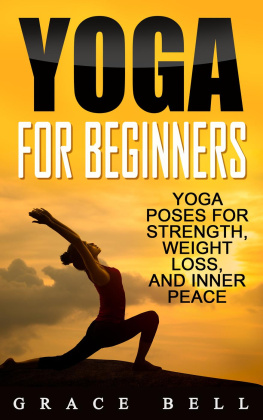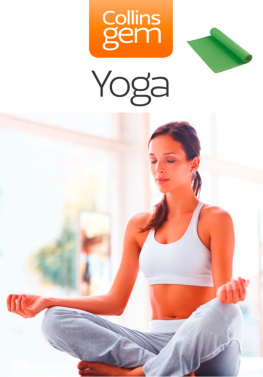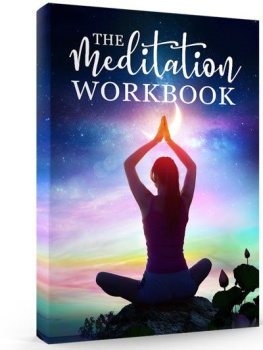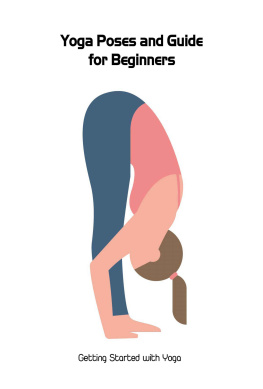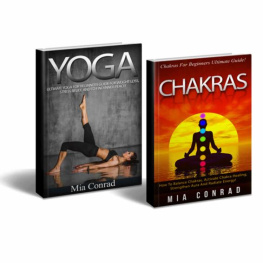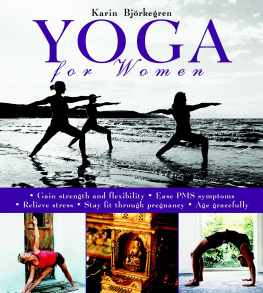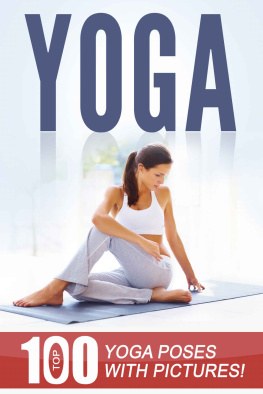Yoga for absolute beginners
Poses for Relaxations, Stress Reduction, Weight Loss, Improve Flexibility and Muscle Strength
Table of Contents
Preface
Chapter 1
A brief introduction to Yoga
Getting prepared
Chapter 2
Attaining Flexibility
Warming up
Mountain Pose (Tadasana)
Warrior Pose 1 (Virabhadrasana-1)
Warrior Pose 2 (Virabhadrasana-2)
Tree Pose (Vrikshasana)
Downward-facing dog (Adho-Mukha Svanasana)
Corpse pose (Savasana)
Chapter 3
Stronger muscles and perfect weight
Triangle Pose (Trikonasana)
Plank Pose (Phalakasana)
Child Pose (Balasana)
Thunderbolt Pose (Vajrasana)
More advanced positions
Plough Pose (Halasana)
Wheel Pose (Chakrasana)
Chapter 4
Living a longer life
Prayer Pose (Pranamasa)
Hand to Feet Pose (Hasta Padasana)
Equestrian pose (Ashwa Sanchalanasana)
Stick Pose (Dandasana)
Salute With Eight Parts Or Points (Ashtanga Namaskara)
Cobra Pose (Bhujangasana)
Sun Salutation (Surya Namaskar)
Chapter 5
Boosting immunity
Shoulder Stand (Sarvangasana)
Fish Pose (Matsyasana)
Chapter 6
Releasing Stress and Anxiety
The Cow-Cat Pose
Headstand (Sirsasana)
Conclusion
Preface
This book was designed for those who have no prior experience of doing yoga. The postures included in this book are aimed at the absolute beginners. Apart from the clear instruction for each posture, yoga breathing or pranayama techniques were applied to each exercise so that the benefits are multiplied. Asanas (Postures) were designed maintaining Astanga Vinyasa (Sequential yoga postures combined with Hatha yoga and Pranayama). It is advised to do the advanced poses in the presence of an expert yoga practitioner, although most of the postures included in this book can be practiced without help or supervision. If you have musculoskeletal pain, neck injury; consult your doctor before practicing. Many of the poses are not suitable during pregnancy. Therefore, it is recommended to consult a physician before starting yoga exercises. Yoga has become popular for countless health benefits and practitioners will start to experience positive changes within a couple of weeks after starting Yoga. This book, however, was not written as a treatment alternative for those who are already receiving medical treatment or in a need for medical attention.
Chapter 1
A brief introduction to Yog a
Yoga for its numerous health benefits has become a part of life for millions across the globe. Anyone can practice Yoga, it does not require instruments, and it does not have any age restriction. General physical exercises focus on physical well-being, and Yoga focuses on balancing, by ensuring a sound body as well as a sound mind. The word Yoga derived from its Sanskrit root Yog which means union. Practicing yoga creates a union between the body and the mind, between the body-mind and nature. And when the union is created, an amazing balancing takes place. For the last several decades, potentials of yoga for healing diseases have become a topic of research. Yoga has become an effective alternative treatment approach for various physical and psychological ailments. Yoga does not just cures diseases; it prolongs the lifespan, thats why the word rejuvenation is often uttered as an attribute to yoga. Although its popularly known as a physical exercise, yoga has many other aspects. As a matter of fact, physical exercise covers a tiny part of the vast Yogic scriptures. But since our aim is to use yoga as a practice for improving our physical and psychological state, we will discuss two aspects of Yoga. One is Hatha yoga; a physical exercise consisted of thousands of postures (Asanas and Mudras), and the other is Pranayama, yogic breathing exercise.
Among the thousands of yoga postures, some postures are basic, can be practiced with ease, some are intermediate which requires some degrees of strength and flexibility following a little caution, and some are advanced which requires some level of physical fitness and supervision in the beginning. Therefore there are few one-size-fits-all postures. However, we dont need to learn all of them, learning ten to twelve postures are more than enough. In this book, we will start from the very basic yoga postures and move towards more advanced level by gradually adding features. Some postures may look difficult at the beginning, but with few days practice, the flexibility and endurance will improve. Yoga can be practiced at any time of the day. But the ideal time is morning, on an empty stomach or 3-4 hours after a large meal. Ideal duration is between 15 to 90 minutes. But even a few minutes of regular practice will make a difference. Some of the poses are specialised, targeting certain groups, aimed at strengthening certain parts of the body or eliminating certain physical or mental illnesses and some are age restricted. A little warm up is recommended before trying strenuous postures. Warm up postures may include twisting, forward and backward bend, sun salutation is also a good warm up if someone is comfortable with it.
Getting prepared
Yoga has to be practiced on bare feet. Clothing should be loose but not too loose, cotton tight and t-shirt is ok. Do not push yourself beyond your limit; there is no competition here and no struggling. But regularity and persistence is paramount for gaining the mastery. If you feel hungry, eat some light snacks and wait for a while; if thirsty, drink some water. Find a quiet place where you wont be disturbed, turn off your TV, cell phone but a soothing music is ok. If you are practicing outside your home, avoid crowded places and direct sunlight. Although no instrument is necessary, you can use some (i.e. yoga block, yoga ball) if you like. If you are practicing on a highly polished floor, use a mat (ideally yoga mat) to avoid slipping and sliding. Remember to breathe, and dont hold your breath while doing yoga. There are instructions for inhaling and exhaling during movements; we will learn it as we move on.
Chapter 2
Attaining Flexibilit y
The flexibility of human body is closely related to longevity. Our body grows rigid, as we grow older; when flexibility improves, it slows down aging. Yoga counteracts aging in many ways; developing flexibility is one of them. The extent of flexibility determines the level of physical fitness. A flexible body has a lower risk of injury. While we boost our flexibility doing yoga postures by stretching different muscle groups, it also improves blood circulation. Better blood circulation promotes the bodys immunity and cut the risks of various diseases. In this chapter, we will start with very simple and easy yoga postures for attaining physical flexibility.
Warming up
Sit in a comfortable position placing your palms on your knees, with your spine straight. Feel as comfortable as you can. Allow the lower part of your body to completely rest on the floor. Feel relaxed and keep your head straight. Take a long deep breath and exhale slowly.
Now gently rotate your head to the right while breathing in. Rotate your head to the left while breathing out. Again, to the right, breathe in and to the left, breathe out. Do it four times. Lower your chin toward your chest and hold the position for five seconds.
Lower your right ear towards your left shoulder while keeping the spine straight, and hold the contraction for five seconds. Take your left ear toward your left shoulder and hold for five seconds.
Slowly stand up with your legs apart. Stand firmly and make sure your weight is evenly distributed on both legs. Inhale and lift your arms up with palms facing each other. Exhale and lower your arms. Again inhale and raise your arms, exhale and lower your arms. Do it at least four times.




